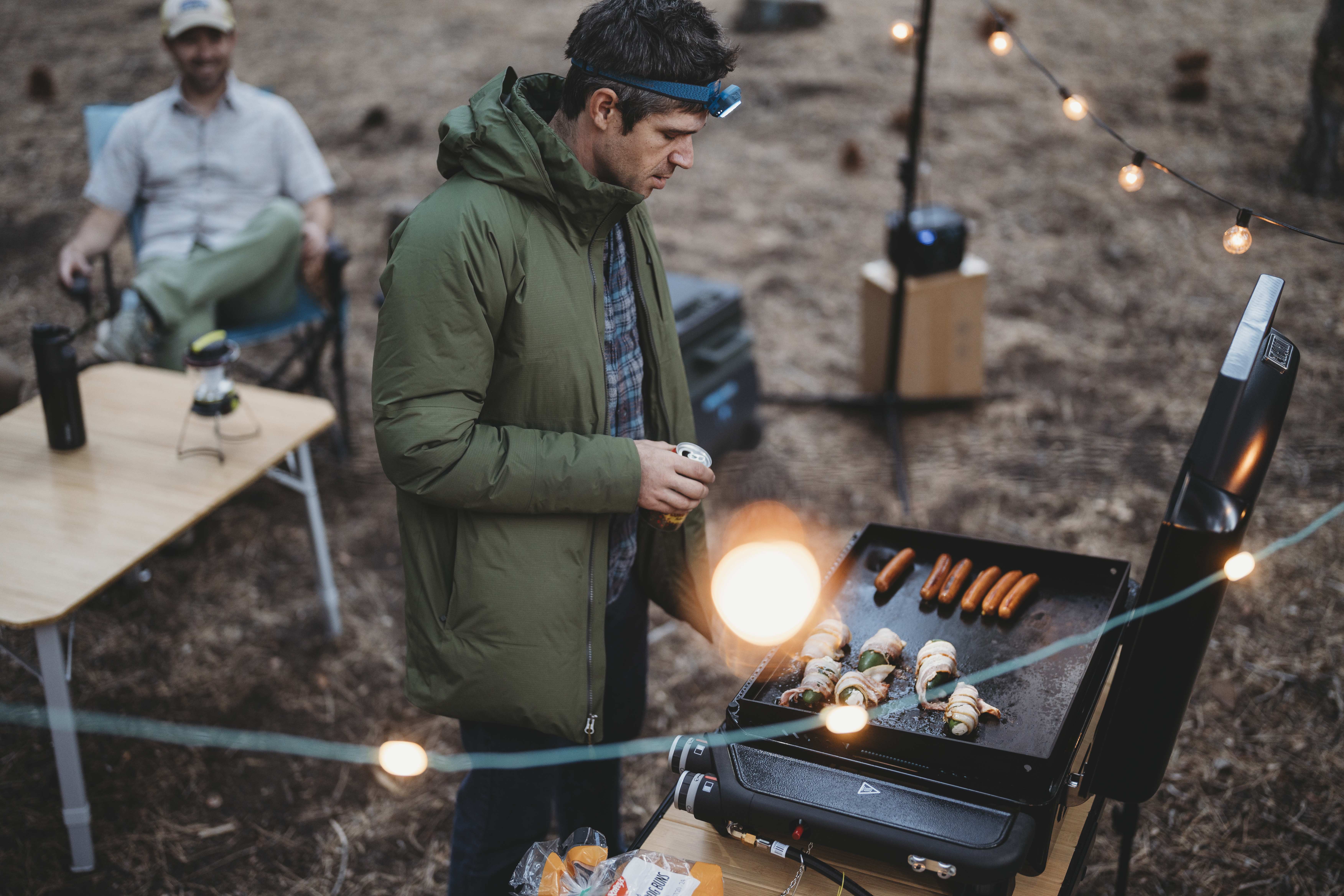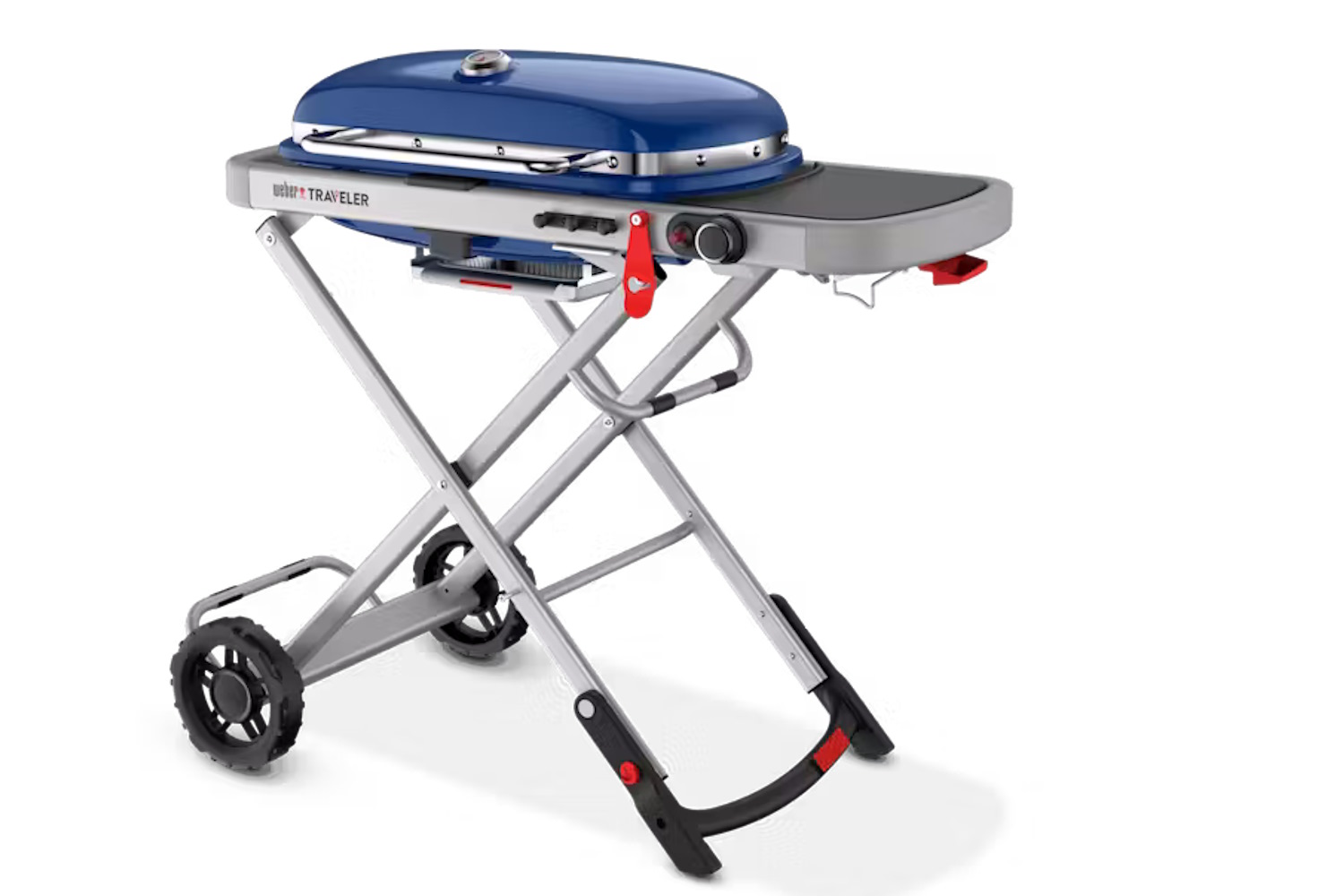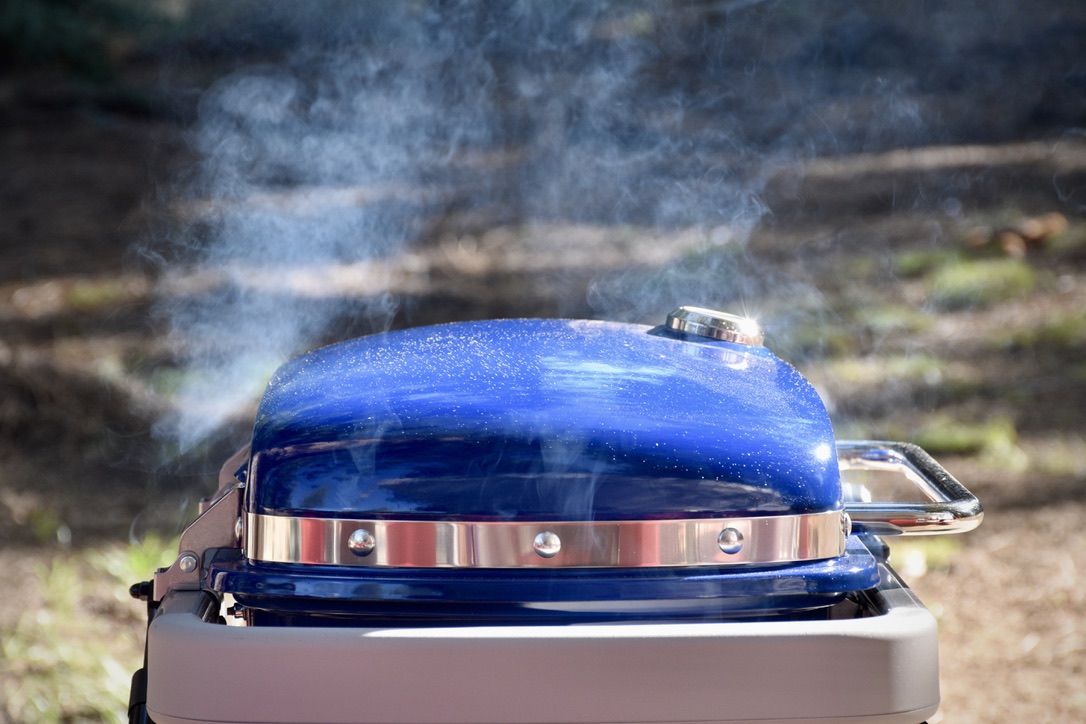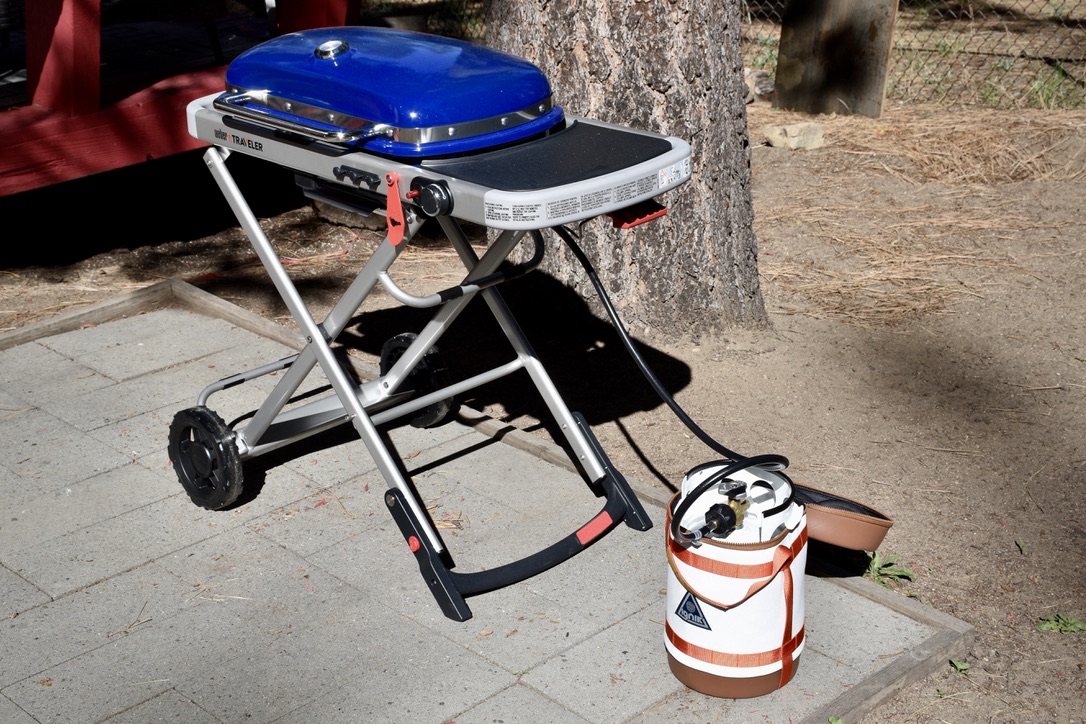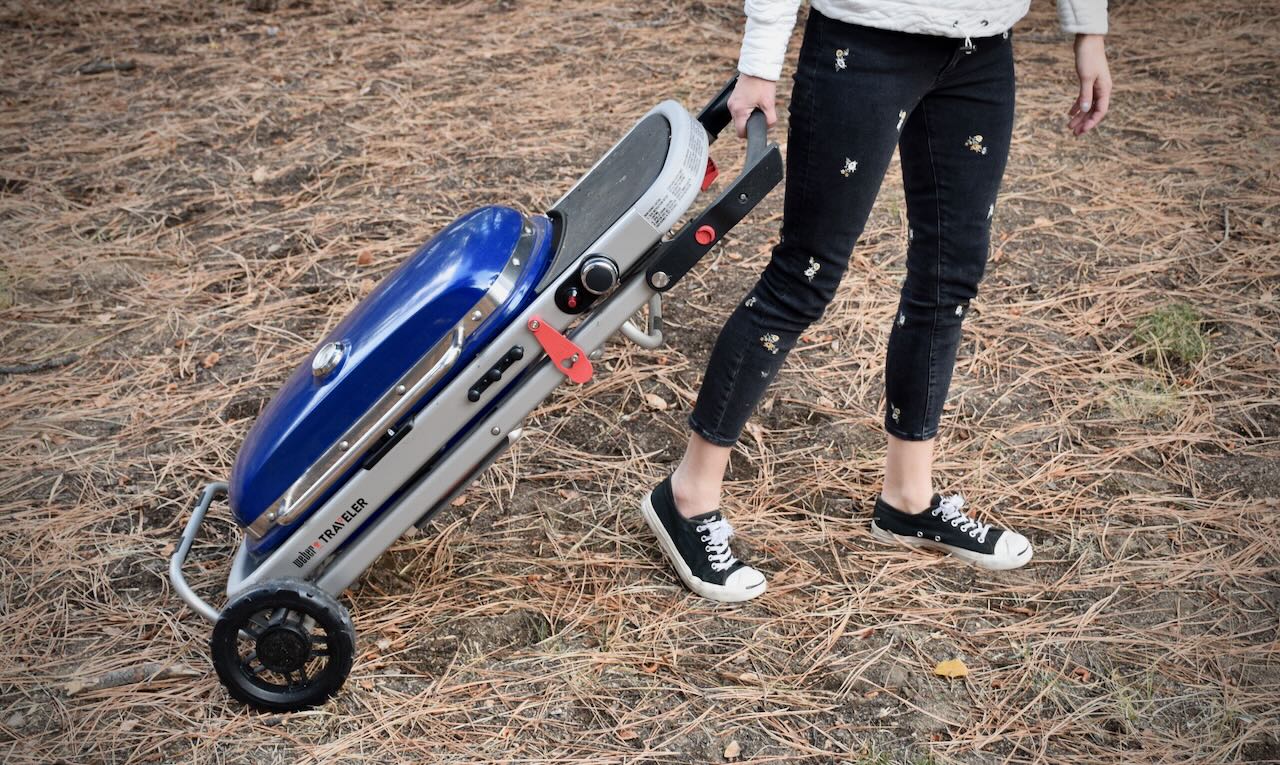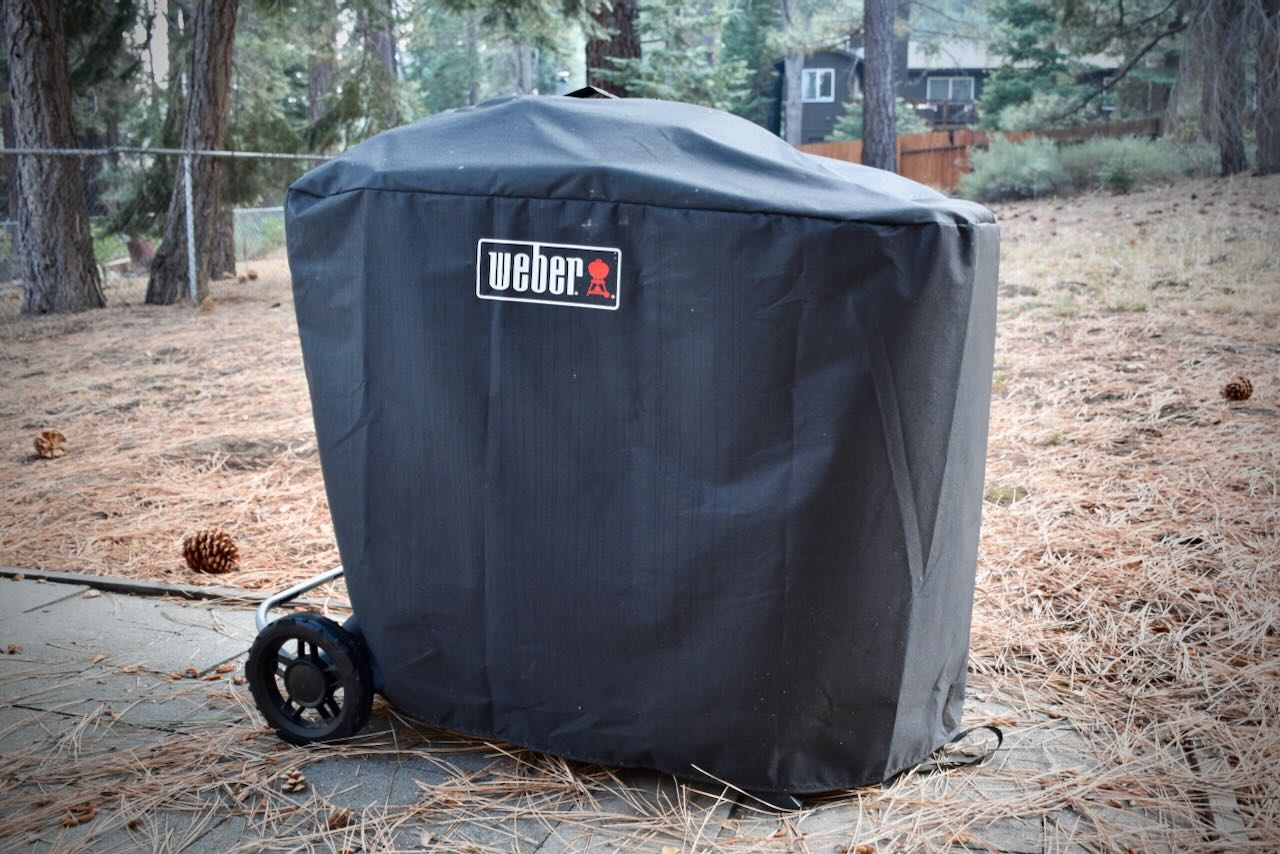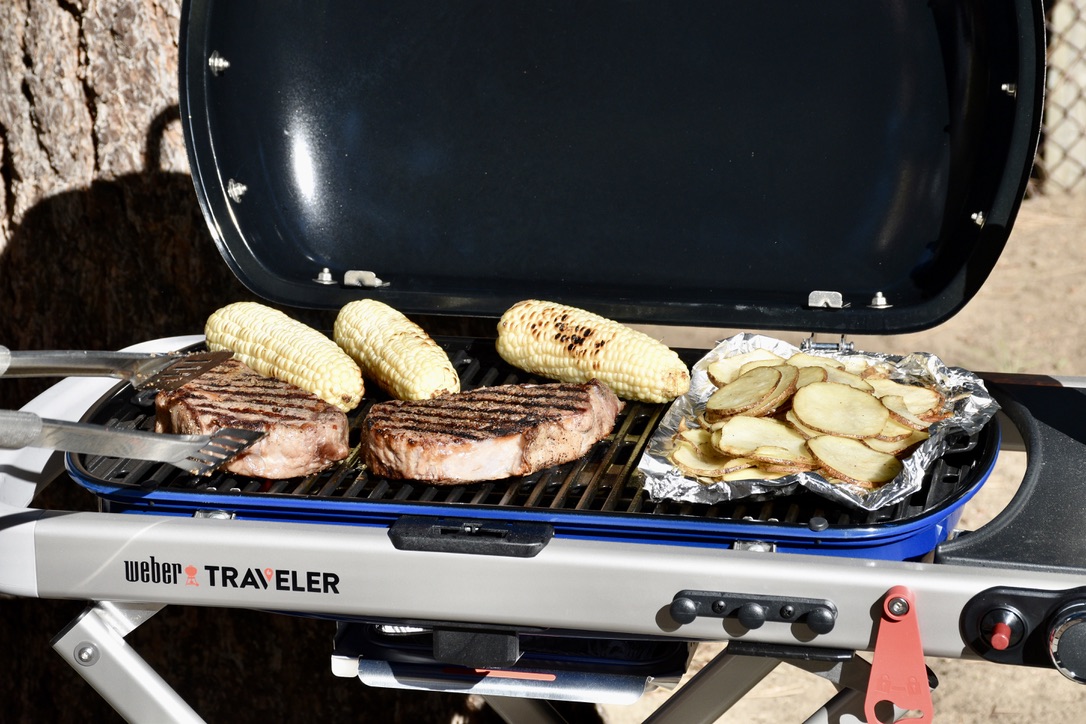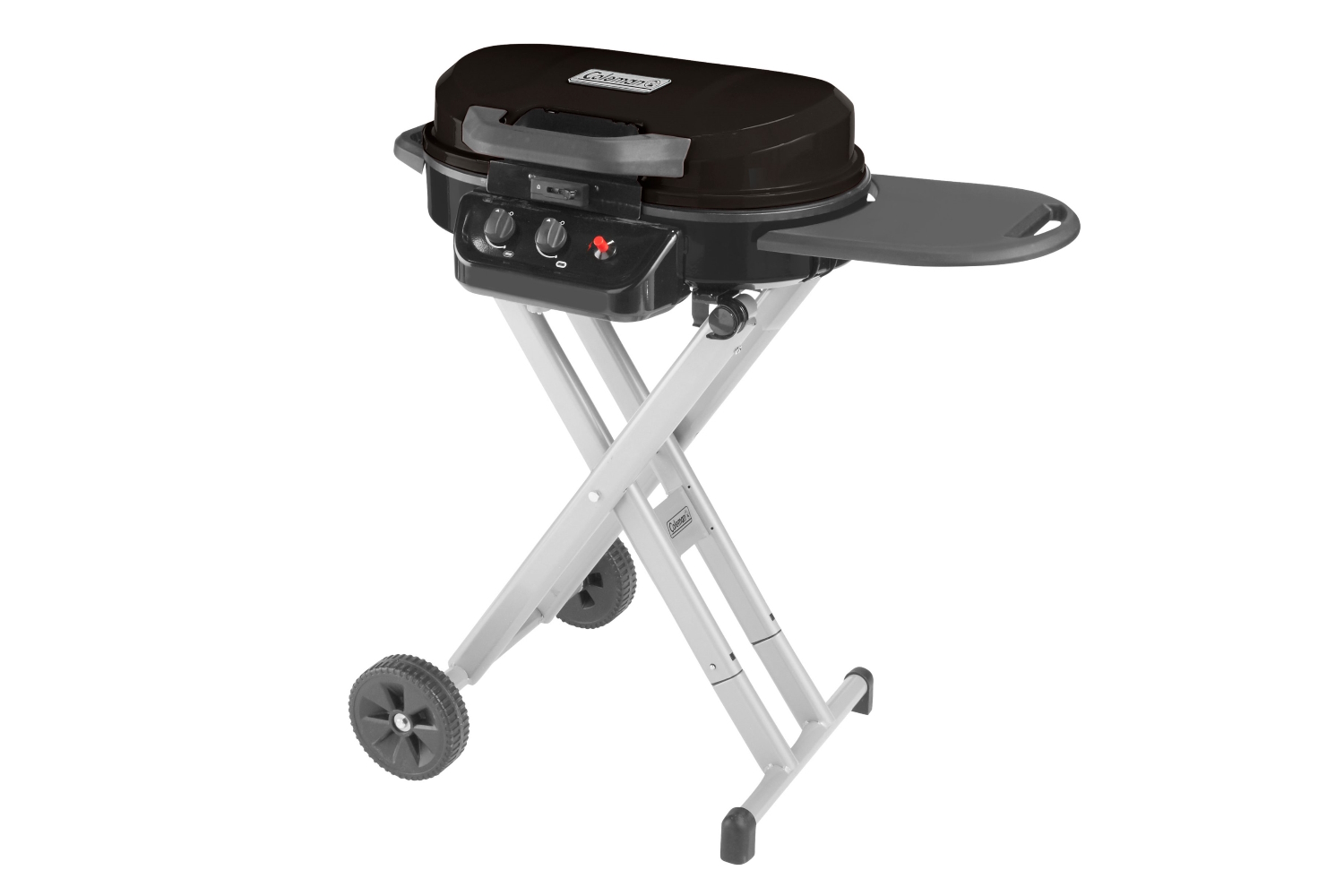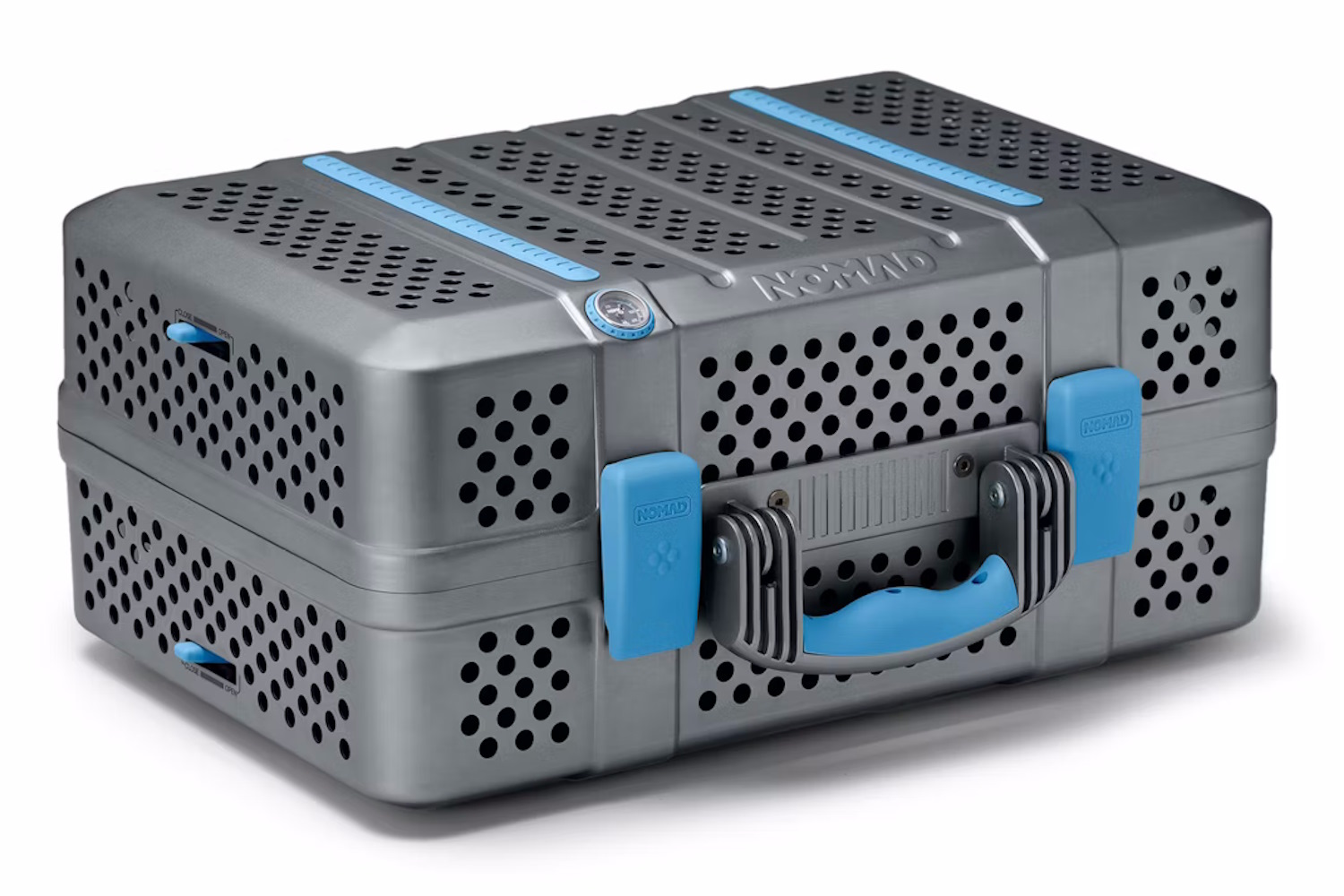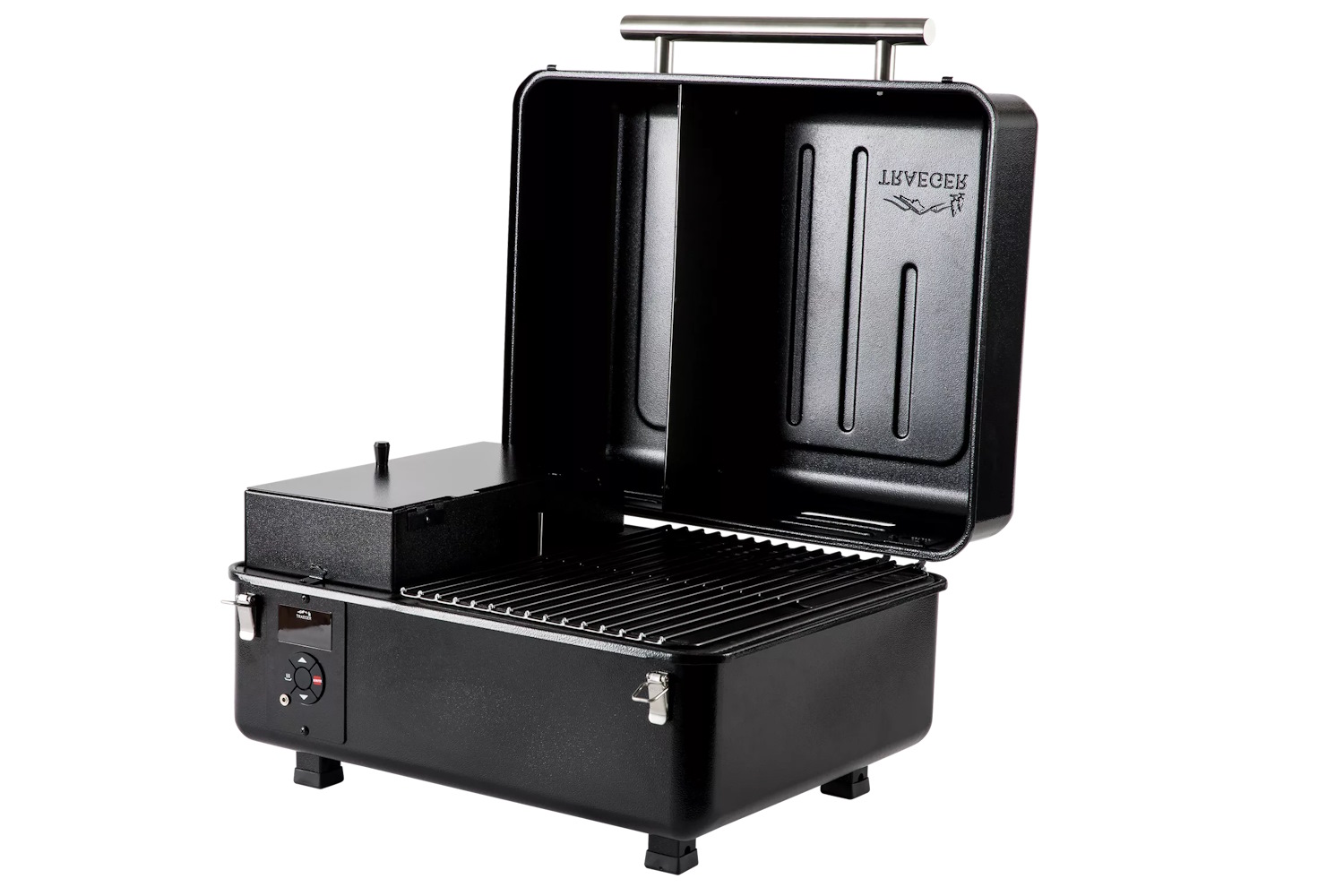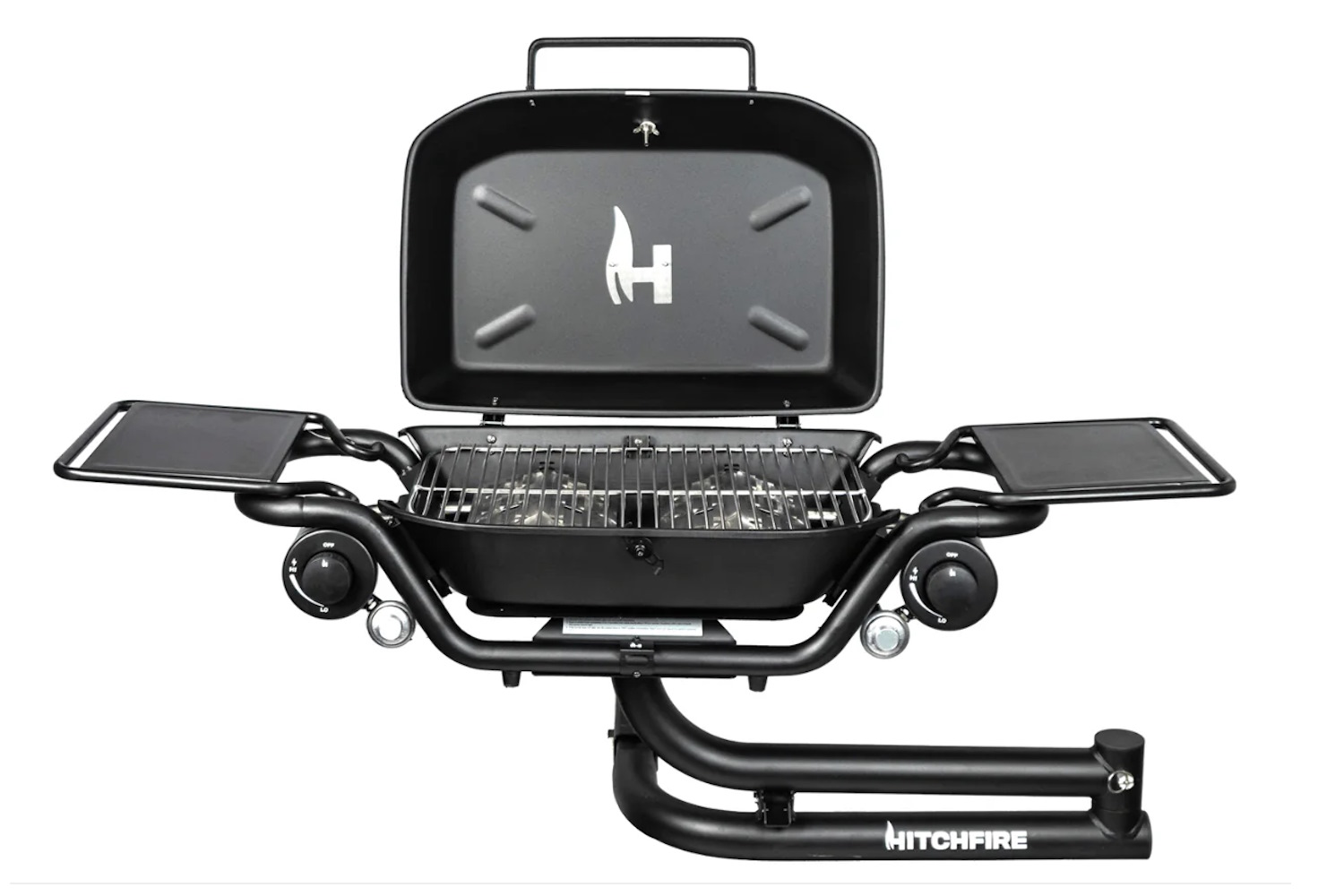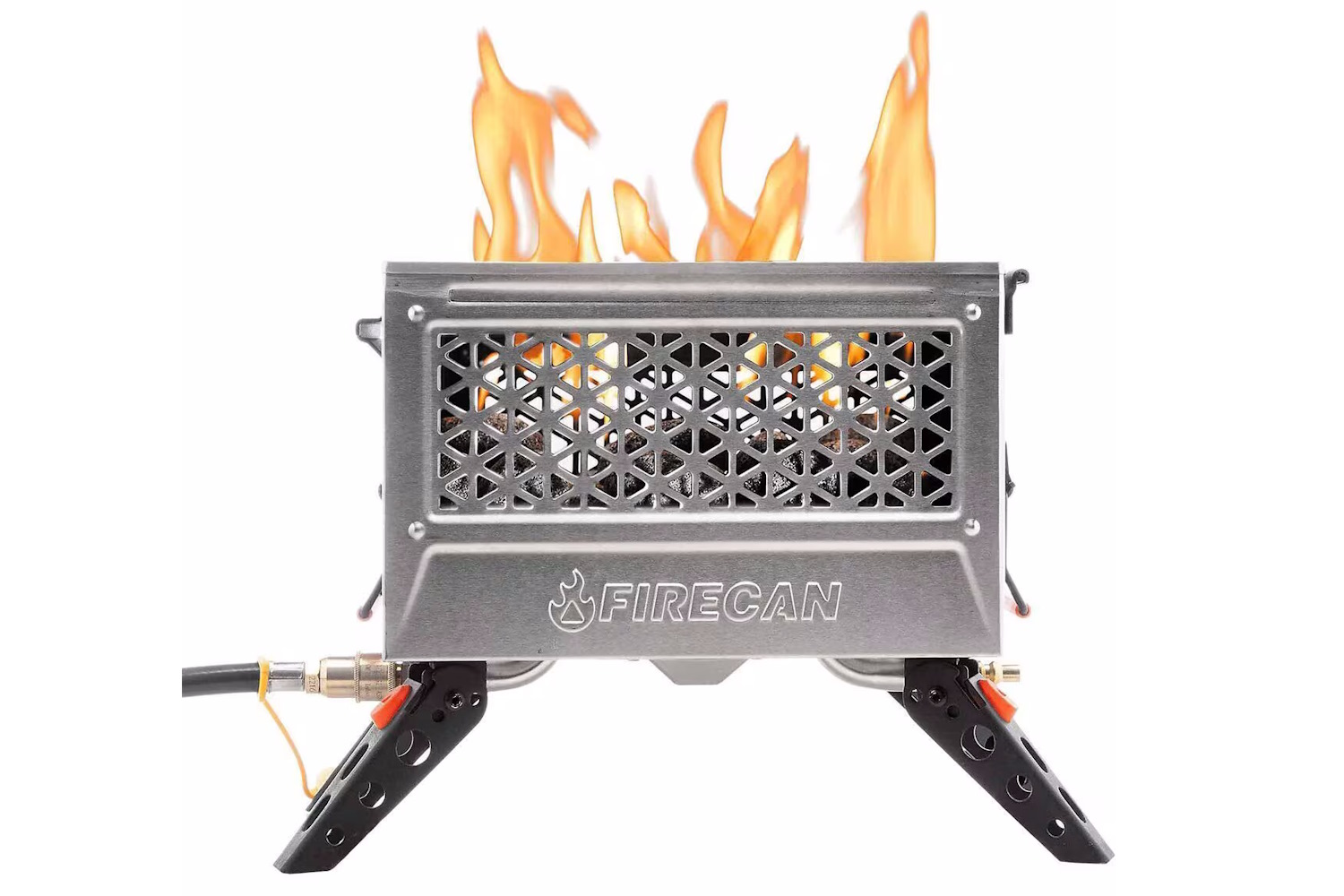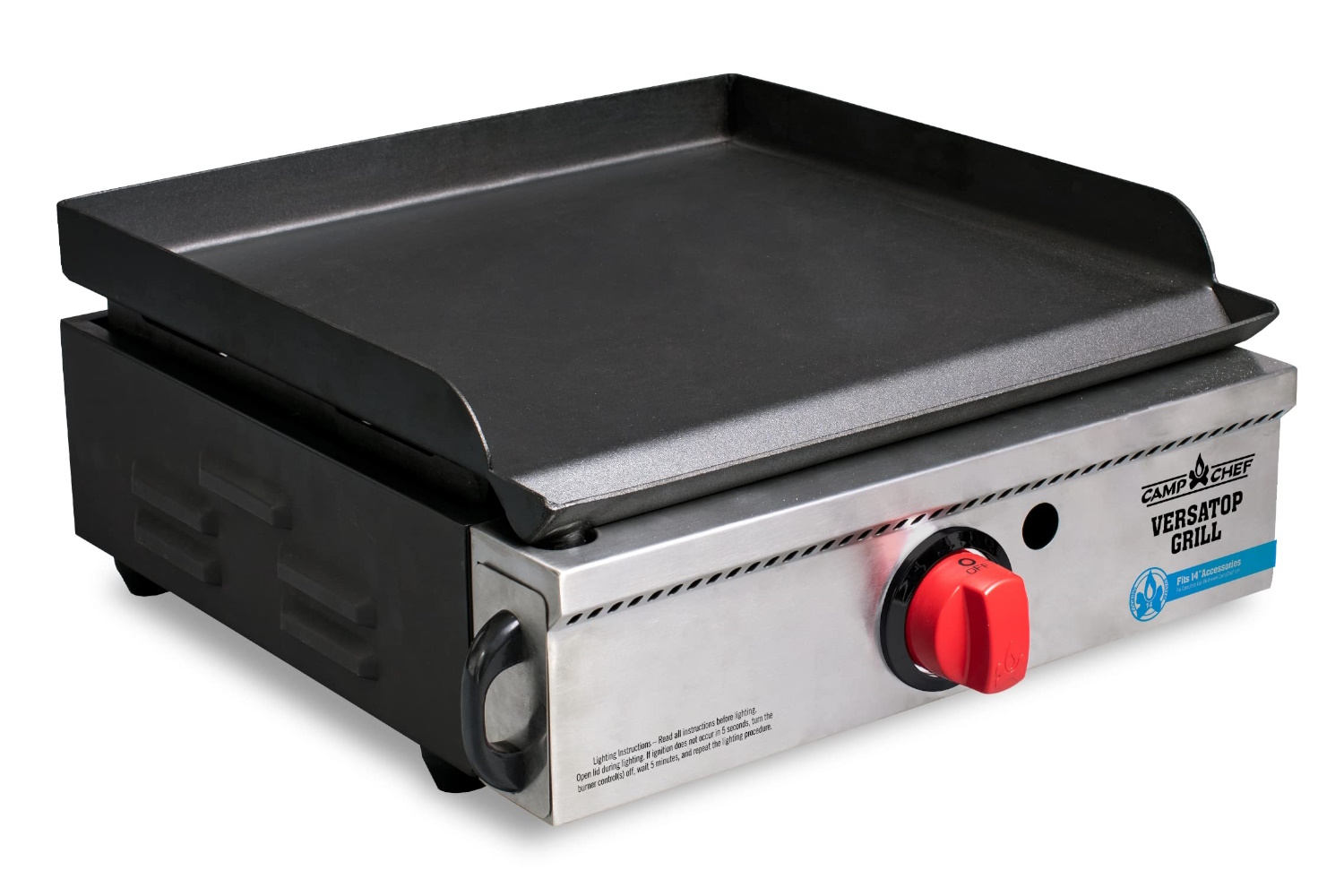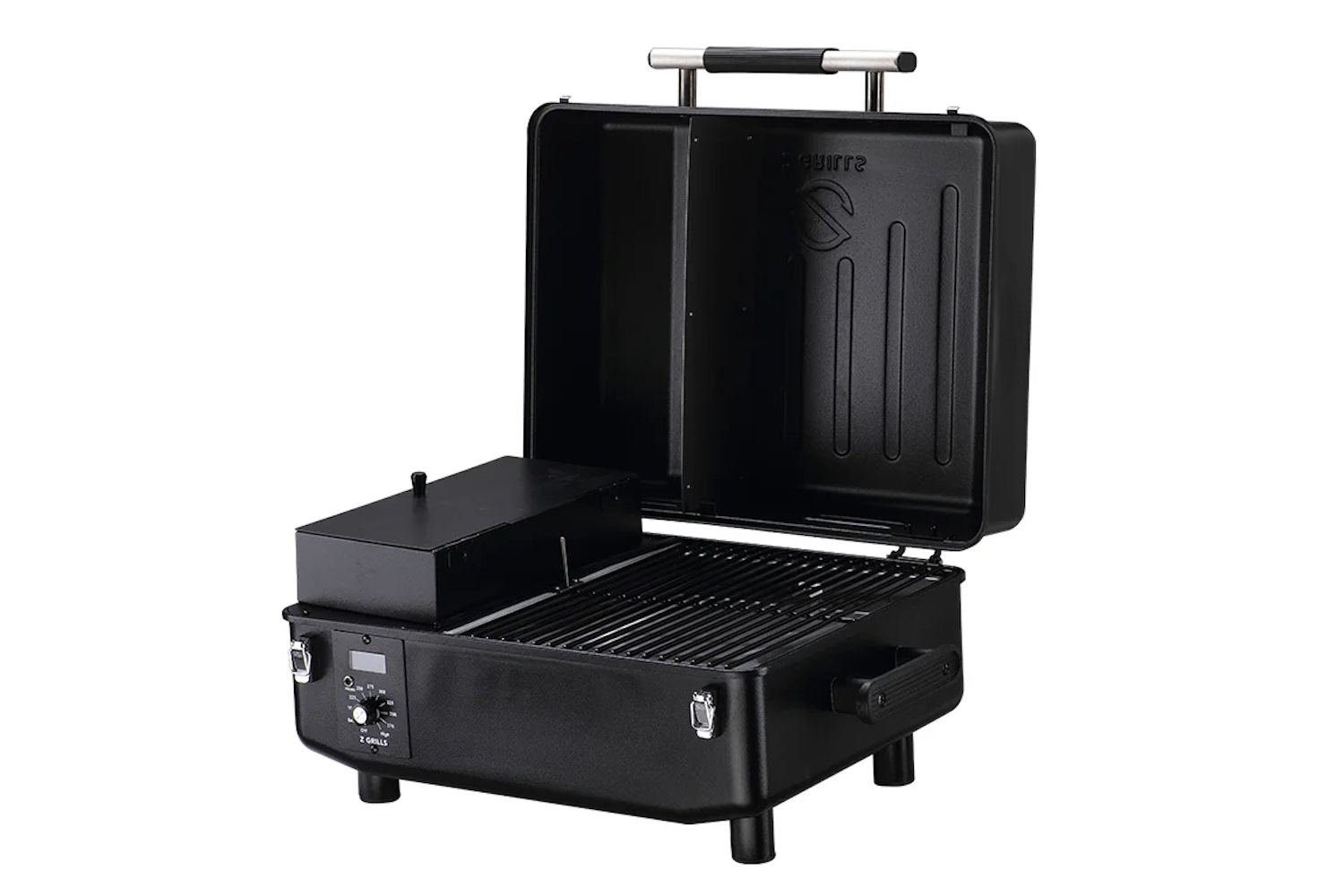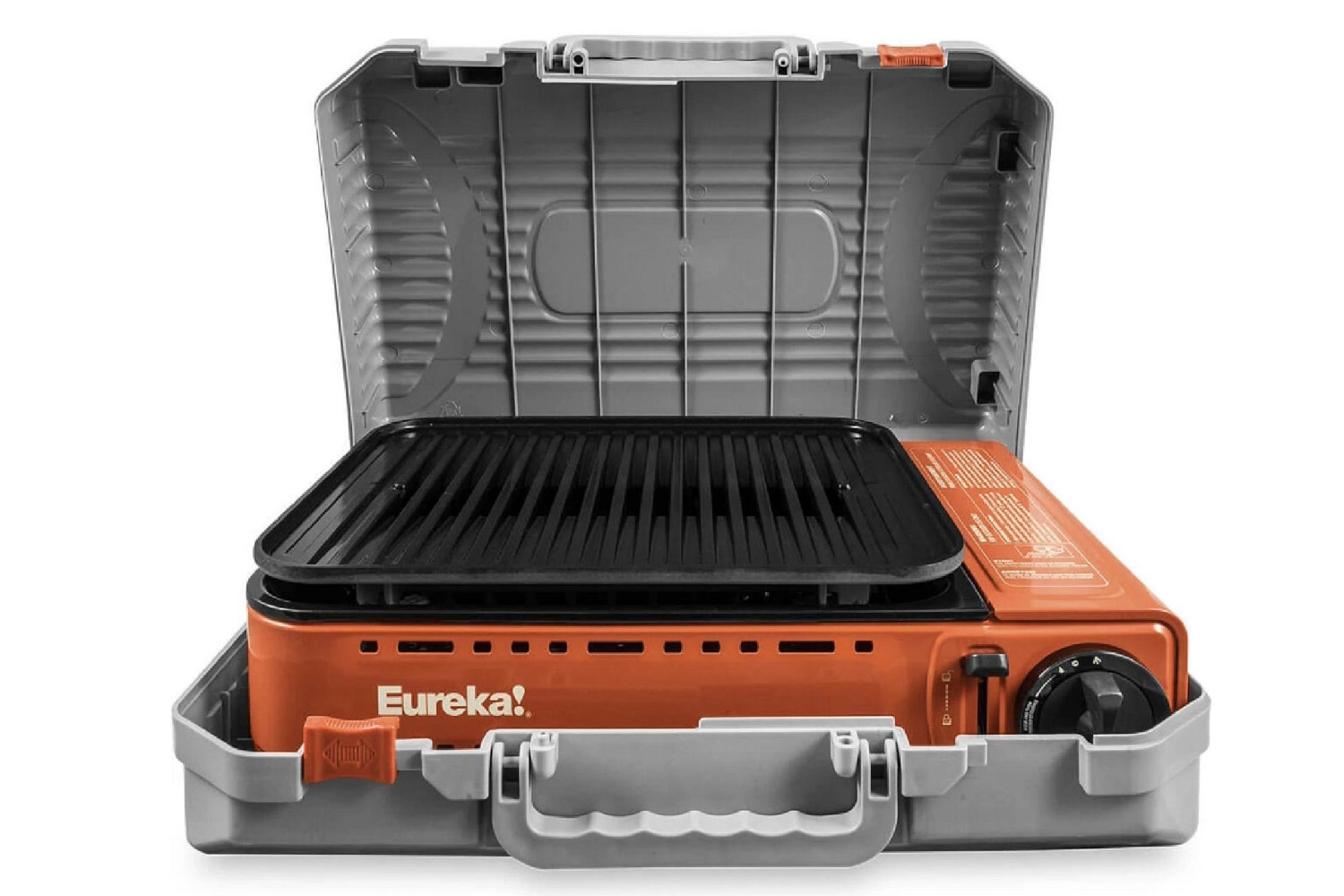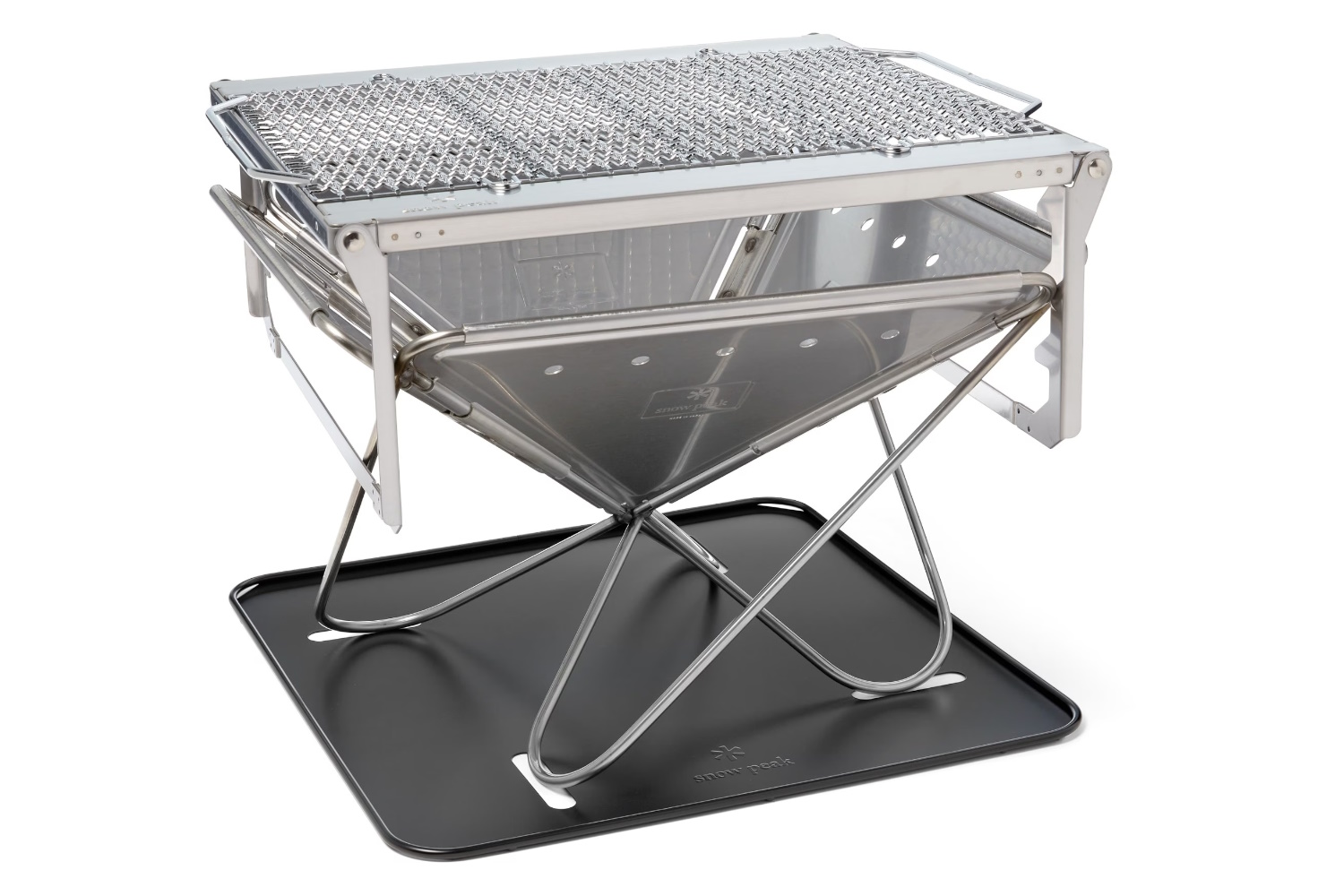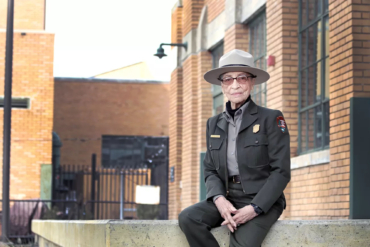We spent the last 6 years testing over 15 of the best portable grills on the market. This Guide analyzes our favorite 12 models. Whether you like searing steaks, smoking pork or chicken, grilling burgers and dogs, or roasting veggies, we’ll help you find the best portable grill for your cooking goals and portability needs.
We tested portable grills fueled by propane, butane, wood pellets, wood, and charcoal, firing up each model at home and in the field. All the while, we carefully analyzed design features and construction quality, heat output and control, ease of cleaning and maintenance, and, of course, portability.
If you’re simply looking for a small and inexpensive charcoal grill for occasional use, check out the Weber Smokey Joe. If you’d like a larger, more refined, more powerful propane grill, we recommend our top pick, the Weber Traveler Portable Gas Grill. Otherwise, check out our in-depth analysis and recommendations below.
Not sure where to start? Our detailed Buyer’s Guide covers the factors to consider when choosing a portable grill, our Price & Value section details cost-related considerations, and our Comparison Chart shows all the models we tested at a glance.
Editor’s Note: We updated pricing and availability in this guide on August 19, 2025. The Weber Traveler 22″ Portable Griddle, once a best pick, is no longer in production and has been removed.
The Best Portable Grills of 2025
Weber Traveler Portable Gas Grill
-
Value
8.4
-
Portability
6.0
-
Performance
8.0
- Footprint: 43.6” x 23” x 37.2"
- Cooking area: 320 sq. in.
- Weight: 49 lbs.
- Fuel: Propane
- Max BTU: 13,000
Pros
- Large cooking area
- Excellent heat output
- Easy to fold, transport, and store
- User-friendly design features
Cons
- Takes up more space in the car than others
- Only one burner control (no dual-zone heating)
Coleman RoadTrip 225
-
Value
8.1
-
Portability
6.4
-
Performance
7.8
- Footprint: 29.3” x 18.5” x 15.2”
- Cooking area: 225 sq. in.
- Weight: 40.5 lbs.
- Fuel: Propane
- Total BTU: 11,000
Pros
- Highly portable
- Convenient folding design
- Includes two burners for better temperature control
- Reasonable price
Cons
- Not as powerful as other grills on the list
Weber Q1200 Gas Grill
-
Value
7.4
-
Portability
8.2
-
Performance
7.2
- Footprint: 24.6" x 40.9" x 20.5"
- Cooking area: 189 sq. in.
- Weight: 31 lbs.
- Fuel: Propane
- Total BTU: 8,500
Pros
- Simple, no-frills design just works
- Helpful folding side tables
- Electric ignition
- Lid with temp gauge
Cons
- Cast iron grate is heavy
- No lock on lid
NOMAD Grill and Smoker
-
Value
6.0
-
Portability
7.6
-
Performance
8.6
- Footprint: 20.5” x 13.5” x 9.5”
- Cooking area: 212 sq. in.
- Weight: 28 lbs.
- Fuel: Charcoal
- Max BTU: N/A
Pros
- Premium construction quality
- Excellent ventilation and thermal efficiency
- Exterior stays cool to the touch
- Simple and easy to use for grilling or smoking
- Suitcase style design is easy to transport
Cons
- Expensive
Traeger Ranger Pellet Grill
-
Value
7.3
-
Portability
7.2
-
Performance
7.7
- Footprint: 13” x 21” x 20”
- Cooking area: 184 sq. in.
- Weight: 60 lbs.
- Fuel: Electric, pellets
- Max BTU: N/A
Pros
- Indirect heat great for slow-cooking
- Hardwood pellets ensure temperature consistency and added flavor
- Easy-to-carry latching suitcase design
Cons
- Requires AC power
- Max temperature is 450 degrees F
Other Portable Grills Tested
-
Value
7.5
-
Portability
8.2
-
Performance
8.1
- Footprint: 39" x 21" x 13"
- Cooking area: 355 sq. in.
- Weight: 72 lbs.
- Fuel: Propane
- Max BTU: 20,000
Pros
- Unique hitch-mounted design
- Easy swinging arm to deploy or stow grill
- Large grilling surface
- Powerful dual 10,000 BTU burners
Cons
- Expensive
- Heavy
- Doesn't allow for any other hitch-mounted equipment
-
Value
7.3
-
Portability
8.7
-
Performance
8.8
- Footprint: 15.3" x 11.4" x 7.1"
- Cooking area: 174 sq. in.
- Weight: 13 lbs.
- Fuel: Propane
- Total BTU: 38,000
Pros
- Easy to transport
- Gas Growlers are adaptable to other camping stoves
- Grills quickly
- Doubles as a portable heater
Cons
- Requires a long match or long-neck lighter
- It’s easy to burn yourself in grilling mode
- Footprint: 17” x 18” x 8”
- Cooking area: 224 sq. in.
- Weight: 24 lbs.
- Fuel: Propane
- Max BTU: 16,000
Pros
- Tons of heat
- Huge grill space
- Excellent ventilation
- Lots of aftermarket accessories
Cons
- Size limits portability
- Scratched during cleaning
-
Value
7.4
-
Portability
7.9
-
Performance
7.7
- Footprint: 25" x 20" x 13"
- Cooking area: 202 sq. in.
- Weight: 40 lbs.
- Fuel: Electric/Pellet
- Total BTU: N/A
Pros
- Good cooking performance
- Reasonably sized cooking area
- Decent price
- Pellet hopper has capacity for 10 hours of slow cooking
Cons
- Requires an electrical outlet to turn auger
- Temperature control not as precise as other pellet grills
-
Value
7.4
-
Portability
9.1
-
Performance
7.8
- Footprint: 11.5” x 16.6” x 4.6”
- Cooking area: 108 sq. in.
- Weight: 8.8 lbs.
- Fuel: Butane
- Max BTU: 7,250
Pros
- Lightweight
- Highly portable
- Simple design works well
Cons
- Fewer features than other models
- Butane may be difficult to find
-
Value
8.1
-
Portability
7.9
-
Performance
8.3
- Footprint: 17.7” x 17.9” x 12”
- Cooking area: 289 sq. in.
- Weight: 28 lbs.
- Fuel: Wood/charcoal
- Max BTU: N/A
Pros
- Excellent modular design
- Stylish & attractive
- Highly portable
Cons
- Inadequate airflow
- Grill feature must be purchased separately
Best Portable Grills Comparison Chart
| Grill | Price | Footprint | Grilling Area | Fuel | BTUs | Weight |
|---|---|---|---|---|---|---|
| Weber Traveler Portable Gas Grill | $499 | 43.6 x 23 x 37.2 in. | 320 sq. in. | Propane | 13,000 | 49 lbs. |
| Coleman Roadtrip 225 | $300 | 27 x 18 x 14 in. | 225 sq. in. | Propane | 11,000 | 26 lbs. |
| Weber Q1200 Gas Grill | $279 | 24.6 x 40.9 x 20.5 in. | 189 sq. in. | Propane | 8,500 | 31 lbs. |
| NOMAD Grill and Smoker | $695 | 20.5. x 13.5 x 9.5 in. | 212 sq. in. | Charcoal | N/A | 28 lbs. |
| Traeger Ranger Pellet Grill | $480 | 13 x 21 x 20 in. | 184 sq. in. | Electric/Pellet | N/A | 60 lbs. |
| Hitchfire F-20 Hitch Mounted | $799 | 39 x 21 x 13 in. | 355 sq. in. | Propane | 20,000 | 72 lbs. |
| Ignik FireCan Deluxe | $350 | 15.3 x 11.4 x 7.1 in. | 174 sq. in. | Propane | 38,000 | 14 lbs. |
| Camp Chef VersaTop | $190 | 17 x 18 x 8 in. | 224 sq. in | Propane | 15,000 | 24 lbs. |
| Z Grills Cruiser 200A | $299 | 25 x 20 x 13 in. | 202 sq. in. | Electric/Pellet | N/A | 40 lbs. |
| Eureka SPRK Camp Grill | $160 | 11.5 x 16.6 x 4.6 in. | 108 sq. in. | Butane | 7,250 | 9 lbs. |
| Snowpeak Tabiki Fire & Grill | $320 | 17.7 x 17.9. x 12 in. | 289 sq. in. | Wood/Charcoal | N/A | 32 lbs. |
Other Portable Grills We Tested:
Coleman Roadtrip 285: The bigger sibling of the Roadtrip 225, the 285 has a 25% larger grilling area and nearly double the heat output. However, it is also nearly twice as heavy, and our main handle broke during assembly, giving us concerns about the construction quality.
Weber Smokey Joe: An affordable and compact charcoal kettle grill, the Smokey Joe is the classic choice for grilling up some quick burgers or dogs at a tailgate, but lacks the size to do much else.
Primus Kuchoma: This lightweight and reasonably powerful portable propane grill is a great choice for grilling in more remote places, but we didn’t like the nonstick grilling surface.
Burch Barrel Flat Packer: A foldable wood or charcoal fire pit and grill, the Flat Packer is rustic and fun to use, but it is not as versatile and capable as a dedicated grill designed primarily for cooking.
How We Tested the Best Portable Grills
The flavor of a hamburger grilled over an open flame, salmon seared on a hot grill, or pulled pork slow smoked over cherrywood makes anyone’s mouth water and is a great way to bring people together, whether at home or on the go. We tested the best portable grills both at home and out in the field to find which models best balance the joy of grilling with convenient portability.
To complete your backyard, camping, or tailgating kit, check out our Buyer’s Guides with the top camping stoves, hard-sided coolers, and the best camping chairs.
Our Expert Testers
Our team of Paul Mandell, Berne Broudy, and Nick Bruckbauer put our lineup of the best portable grills to the test.
Paul loves to grill and often finds himself manning the helm at neighborhood get-togethers. From tri-tip to hot dogs and corn to squash, he was particularly excited to take these grills on his adventures around his home of Bishop, Calif. From backyard barbecues with friends, to tailgates after a day of fishing, to après bike park laps, Paul truly tested the portability of these grills by using them in some adventurous locations.
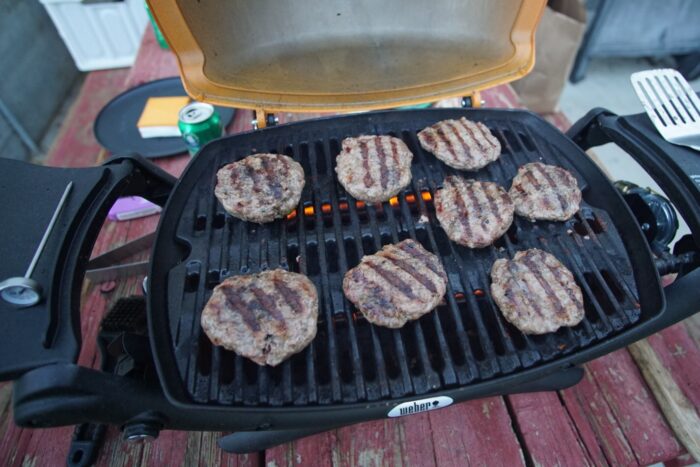
Based in Vermont, Berne is an experienced all-around outdoorsperson and our slow-cooking specialist. She tested the pellet grills in this Buyer’s Guide and produced beautifully cooked chicken, ribs, and pork roasts. An active cyclist, skier, and traveler, Berne appreciates products that provide portability without sacrificing cooking performance.

Nick is a year-round resident of South Lake Tahoe, Calif. With countless beaches, trailheads, and ski areas within a short drive, he was on the lookout for the best “quiver of one” portable grill that could easily transition from a beach cookout with relatives to a campout with friends to a home-cooked meal in the backyard. With a two-year-old daughter in tow, Nick appreciates simple and intuitive products that work well without wasting time or effort.

Our Testing Process
As curious and analytical gear nerds, we thoroughly examined every aspect of these portable grills, from the initial unboxing and assembly process to the final cleanup and storage after cooking, and everything in between.
Upon receiving these grills, we excitedly tore into them just as you would. Since grills can be a heavy and awkward item to ship, we evaluated the boxing and packaging quality to make sure each grill was packaged safely and could be unboxed without too much effort. From there, we read through any directions, ensured all necessary pieces were present, and assembled each grill. Most of the grills came mostly assembled, typically with just a few extra pieces or accessories to attach.
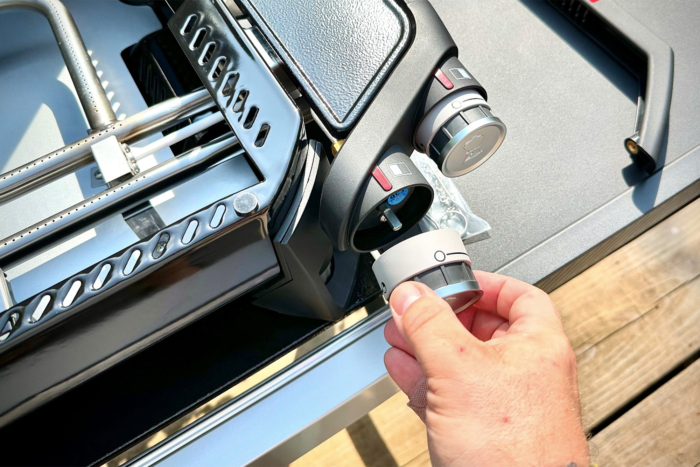
After each grill was assembled and set up at home, we got to the fun part: grilling! On various occasions, we cooked up a smorgasbord of delicious meals, including steaks, chickens, tri-tip roasts, smash burgers, brats, hot dogs, corn, veggies, and potatoes. We thoroughly evaluated cooking performance, comparing each grill’s cooking surface, heat output, and temperature control. We examined different features such as fuel sources, ignition systems, ventilation, and thermometer accuracy. We noted which grills were easiest to use and which ones provided more user control for more advanced cooking methods.
Finally, we packed up each grill and set out to numerous fun locations for some grilling on the go. We paid close attention to each grill’s size, weight, ease of transport, and ease of cleaning and storing after use. We noted any drops in performance or convenience between using a grill at home or on the go. We cooked up some beautiful meals in some beautiful places, and are happy to share our results with you.

Buyers Guide: How to Choose a Portable Grill
Fuel Source
The portable grills we tested use various fuels, including gas (propane or butane), wood pellets, charcoal, or firewood. Electric grills are also on the market, but we opted not to test those. Each fuel source has its advantages and disadvantages.
Gas (Propane or Butane)
Most of the grills we tested in this Guide are propane gas grills. Propane is a reliable fuel source readily available in various sizes, from smaller 1-pound canisters that you can pick up at most sporting goods stores to larger 20-pound refillable tanks that you might see at your grocery store or gas station.
The obvious advantage to gas grills is that they start nearly instantly, get up to heat very quickly, and cool down quickly after cooking. This makes gas a great fuel choice for a portable grill, since you don’t have to wait as long for the grill to heat up and cool down when you’re on the go. Simply fire up the grill and let it get up to heat, cook your meal, and the grill should be cool and ready to pack up by the time you’re done eating. Transporting a gas canister can also be easier and cleaner than transporting charcoal or firewood.
Gas grills also provide better temperature control than charcoal or wood fires. Most gas grills state a heat output rating (in units of BTU), so you can easily familiarize yourself with the maximum heat output and adjust the flame level as needed to reach different temperature levels. Gas grills are also pretty fuel-efficient, providing several cooking sessions before needing to refill or replace the fuel.
To combat the waste from single-use 1-pound green canisters, Ignik produces compact and refillable Gas Growlers — essentially mini-versions of larger refillable propane tanks. During our testing process, we used a 5-pound Ignik Gas Growler. It is available in three sizes (3.8, 5, and 10 pounds), is refillable, and comes with a handy padded carrying case that allows for easy storage and transportation. This is a great option for those who are tired of tossing green canisters in the trash after each outing. According to Ignik, “over 40 million end up in landfills every year.”
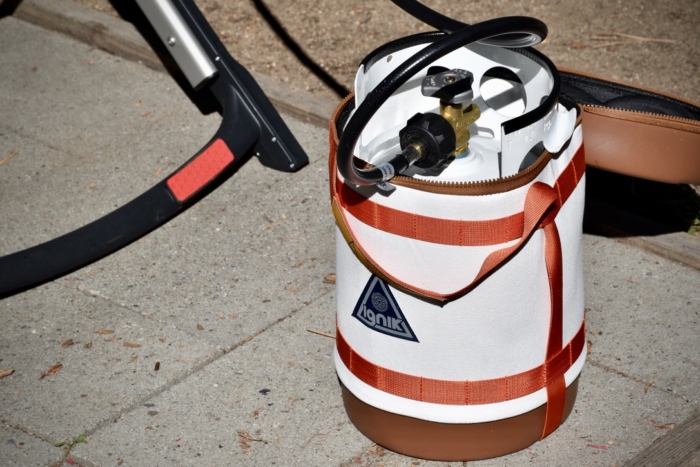
We also tested one gas grill — the Eureka SPRK — that is powered by butane. Butane usually isn’t quite as readily available around town as propane is, but there are various online outlets where you can purchase 8-ounce canisters.
Wood Pellets
Wood pellets are an interesting fuel source that provides the best of both worlds — precise temperature control and a natural, smokey flavor. This makes wood pellet grills — like the Traeger Ranger Pellet Grill and the Z Grills Cruiser 200A — excellent for slow cooking or smoking foods like ribs, chicken, or pork roasts.
It should be noted that these grills require an electrical connection that programs the pellet hopper to continually feed pellets into the grill to maintain the desired temperature. Various wood pellet types are available so that you can customize the smoky flavorings imparted onto your food.
The downside of wood pellet grills is that they typically have a lower maximum temperature, so they’re not as well-suited for cooking that requires direct heat, like searing steaks.

Charcoal
Charcoal is a classic grilling fuel that is readily available, pretty easy to use, and adds a unique flavor to your food. The main advantage of charcoal grills is that they are usually simpler and have fewer moving parts than gas grills, typically making them more affordable. The exception to this is the high-end NOMAD Grill and Smoker, which is one of the most expensive portable grills we tested.

The primary disadvantage of charcoal grills is that they take longer to heat up and cool down than gas grills. This can be an issue if you’re on the move, trying to feed hungry people, or hustling to pack up and leave after your cookout. But we have to admit we have a certain nostalgia when it comes to drinking a beer around the grill with friends or family while waiting for it to heat up. On days when we have plenty of time to lounge around, we love hanging out around a charcoal fire.
Transporting charcoal grills can also be a little messier from the leftover ashes, and you must also consider your ignition source (lighter fluid, newspaper, or a chimney starter, for example).
Firewood
Firewood can be more difficult to transport, messier to handle, and take longer to heat up and cool down, but it is perhaps the most rustic fuel for grilling. Depending on your location, it may be scarce or readily available. Wood fires can also be less efficient than other fuel sources and challenging to maintain precise temperature control, but they can impart a unique flavor to your food.
Most charcoal grills can also be used with firewood, and there are a number of modern portable fire pits that double as grills.
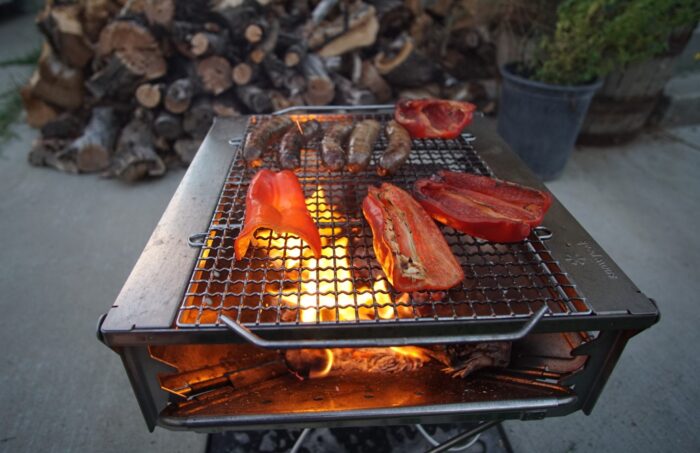
Heat Output and Control
Finding the right portable grill requires striking a balance between portability and heat output. Typically, a grill with a higher heat output will be larger and more cumbersome, and a smaller and lighter grill will have a lower heat output. Finding your right balance depends on how many people you’ll be cooking for, what type of foods you’ll be grilling, and how frequently and how far you travel with your portable grill.
Heat Output
Most gas grills have a listed heat output rating in units of BTUs. The gas grills we tested range in output from 7,250 BTUs on the Eureka SPRK up to 38,000 BTUs with the Ignik FireCan Deluxe. Higher heat output allows you to cook more food over a larger cooking area at the same time, and allows you to cook at hotter temperatures. A lower heat output might be sufficient for grilling a few brats or hot dogs, but a higher heat output might be required for searing steaks or cooking a full family meal.
Our two favorite grills we tested — the Weber Traveler Gas Grill and the Weber Traveler Portable Griddle — have heat outputs of 13,000 BTUs and 16,000 BTUs, respectively. Both models provide plenty of heat to cook a full meal all at the same time. We cooked a full dinner of ribeye steaks, corn on the cob, and sliced potatoes on the Traveler Gas Grill, and a full breakfast of eggs, bacon, and potatoes on the griddle.
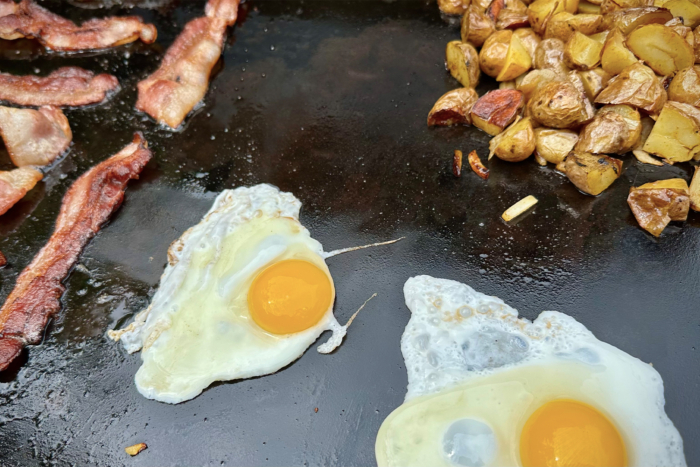
Wood and charcoal grills don’t have standardized BTU ratings, so the heat output is a function of how big and hot you build your fire. You can get a wood or charcoal fire cranking hotter than a gas grill, but you sacrifice temperature control and precision. A larger fire takes longer to heat up and cool down, both considerations if you’re grilling on the go.
Heat Control
While the maximum heat output is important, so too is your ability to control the heat. Whether you’re smoking a rack of ribs or roasting a tri-tip, many dishes require you to consistently stay at a specific temperature range throughout the cooking process. While most grills have a built-in thermometer, the temperature can vary widely at different spots inside your grill, so it may be better to use a standalone grill thermometer if you require a precise temperature.
Wood pellet grills have some of the best temperature control, since you can set your desired heat level on a digital controller, and then the grill will automatically feed fuel pellets into the grill to maintain the correct temperature. Gas grills can be turned up or down to adjust the temperature on the fly, and many have dual burners so you can set up to cook in direct and indirect heating zones. Wood or charcoal grills may have less precision, but you can still dial in a pretty accurate temperature range by adjusting the air vents and adjusting where you place your food in relation to the heat source.

Cooking Space
A grill’s cooking space is also typically inversely related to its size and portability. Obviously, a larger grill will have more cooking space and may be more powerful, but it will also be bigger and heavier. Whether you’re cooking for one or two people, a family, or a little league team, the cooking space should be a primary consideration.
The smallest grill we tested is the Eureka SPRK. With 108 square inches of cooking area, it’s ideal for a handful of brats or a couple of burgers. Other options like the Hitchfire F-20 Hitch Mounted, the Weber Traveler Griddle, and the Weber Traveler Gas Grill have over 300 square inches of cooking space, and are appropriate for big family meals or large groups of folks.

Size & Portability
If you plan to transport your grill in a compact car or carry a grill to a far-from-the-road scenic overlook, you’ll need an option that packs smaller and weighs less than if you’re driving your grill to a campsite and unloading it on the picnic table. The Eureka SPRK Camp Grill is the lightest and most portable option we tested, weighing just 9 pounds.
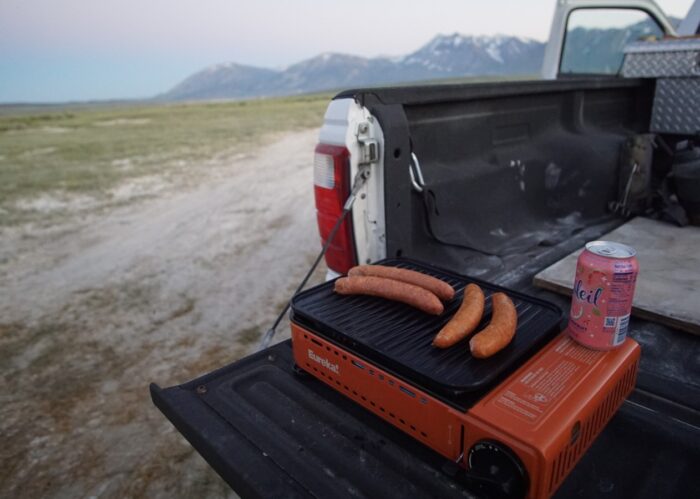
Some portable grills like the Weber Traveler Gas Grill and the Coleman RoadTrip 225 are heavier and have larger footprints, but come mounted on a foldable stand with roller wheels, making transport surprisingly easy despite their larger size.
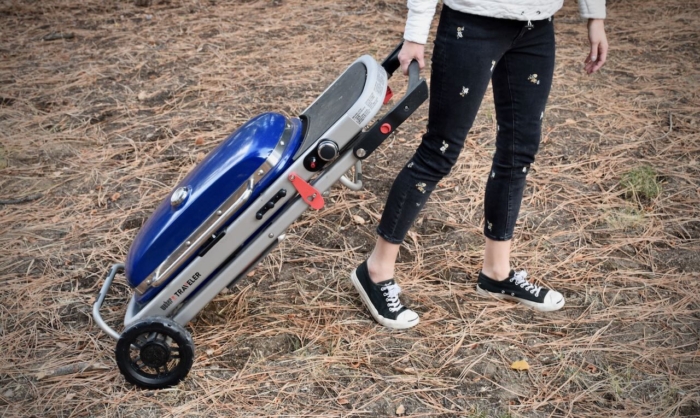
Other options, like the NOMAD Grill and Smoker, the Traeger Ranger Pellet Grill, and the Z Grills Cruiser 200A are built into a latching suitcase-style carrying case, making storage and transport a breeze.

The Weber Traveler 22″ Portable Griddle is the least portable grill that we tested. It weighs over 50 pounds thanks to its hefty griddle insert, and doesn’t have a latching lid or any added carrying handles. You pretty much have to grab it with two hands and haul it around. Fortunately, the griddle insert is removable, which makes transport much easier if you take separate trips with the griddle insert and the grill frame.
Price & Value
Budget Portable Grills
The lowest-priced portable grill that we included in this Buyer’s Guide is the Eureka SPRK at $150. At this price range, you can get a nice lightweight, portable grill, but you’re sacrificing heat output and cooking area. The SPRK has the smallest cooking area and the lowest output rating of any of the grills we tested. The only other model under $200 that made the cut into this Guide is the Camp Chef VersaTop at $190, but you’ll have to shell out some extra cash for the additional accessories that really add to this grill’s versatility.
If you’re really looking for a budget model without any bells and whistles, the Weber Smokey Joe costs just $46. It is a capable charcoal kettle grill, but it only has enough space for 4-5 burgers or a pack of brats.
Mid-Tier Portable Grills
Most of the portable grills that we tested fall into the $200-320 price range. This is a nice sweet spot where you can find a great balance of performance, features, and portability at a reasonable price. In this range, you could get our favorite portable griddle, the Weber Traveler 22″ Portable Griddle ($299), our favorite tabletop grill, the Weber Q1200 Gas Grill ($259), or a stand-up grill like the Coleman RoadTrip 225 Stand-Up ($275). These grills have larger cooking areas, more powerful burners, and higher-end features than the budget models, without breaking the bank or becoming too cumbersome.
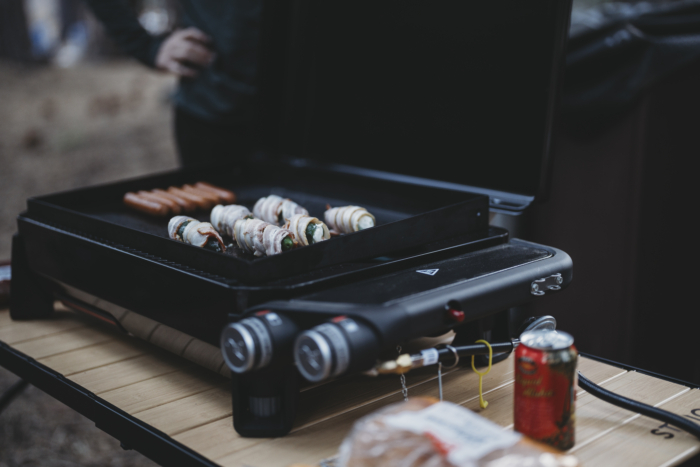
Premium Portable Grills
Once you start looking to spend around $400 or more on a portable grill, you start getting more premium options and flagship models from more big-name manufacturers. Our top overall pick, the Weber Traveler Portable Gas Grill ($399-449), sits in this price range and is one of Weber’s flagship portable grill models. In addition to a large cooking area and a powerful 13,000-BTU burner, it has a high-end folding mechanism that makes it incredibly portable for a relatively big and heavy grill. It also has an all-around high-end feel and construction quality.
The NOMAD Grill and Smoker ($695) and the HitchFire F-20 Hitch Mounted Grill ($649) top our list as the highest-priced portable grills, but they also fill specific niches. The NOMAD is built into an aluminum suitcase, and even though it’s just a charcoal grill, the construction, fit, and finish make the grill a head-turner when you’re out and about. The HitchFire, similarly, is a capable propane grill similar to a few of the others we tested, but comes with a hitch-mounting kit that makes it great for camping or overlanding.

Frequently Asked Questions
The grills on our list range in weight from 8.8 pounds to 72 pounds and everywhere in between. Depending on your intended use, there is likely a grill that will meet your exact weight and dimension needs.
Before you buy a grill, you’ll want to ask yourself what its intended use is. Are you car camping? Tailgating? Picnicking? You’ll want to choose a grill that’s light enough to carry and offers enough space and heat to cook for you and your crew. Check out the comparison table above for cook space and output stats each of the grills on our list.
Absolutely not. These grills emit CO2 and should never be used indoors. Additionally, open flames from wood or charcoal present an obvious fire and smoke hazard and should always be used outside in well-ventilated areas.
The time-honored debate rages on. Some folks argue that you can’t replicate the added taste of charcoal with a gas grill — which is true when smoking meats or grilling fish. Charcoal grills offer the option of adding wood for flavor, as well as using indirect heat by stacking briquettes opposite your food.
Charcoal is heavier and messier and takes much longer to cool off when you finish grilling. Propane, by contrast, is super convenient because of its small footprint, light weight, and easy clean up. The propane grills on our list offer excellent heat modulation, almost instantaneous heat, and quick cooldown.
For our money, propane is the move. However, if you are interested in some of the benefits of charcoal — like the ability to smoke your food or cook with indirect heat — you might not be a propane person.
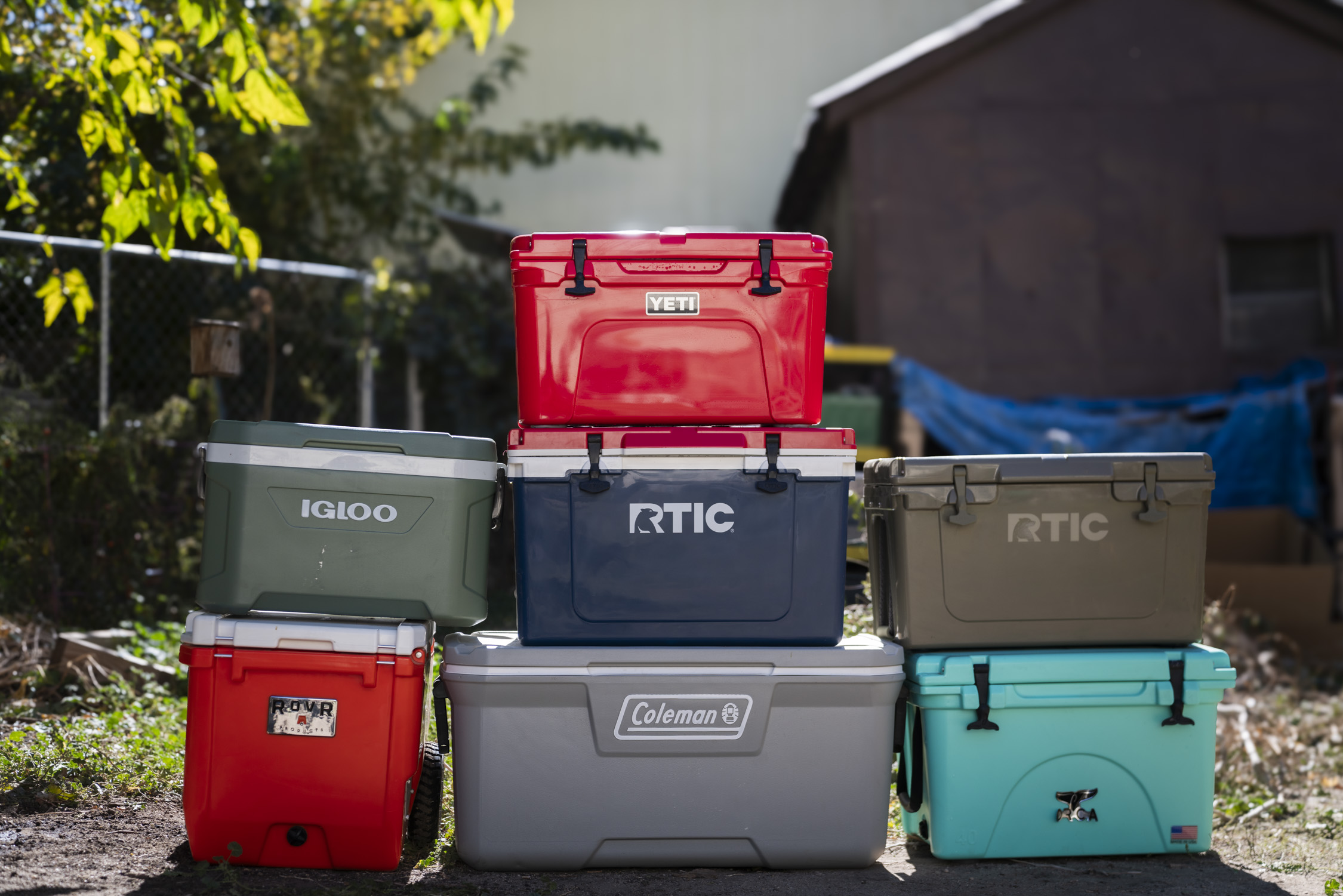
The Best Coolers of 2025-2026
We tested the best hard coolers of 2025 with options for every budget. Top picks include Dometic, YETI, RovR, and more!

The Best Camping Chairs of 2025
We found and tested the best camping chairs for every use and budget. Top picks include REI, Coleman, NEMO, and more.
